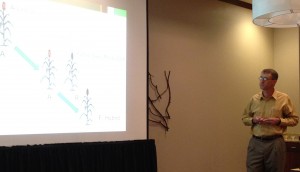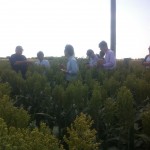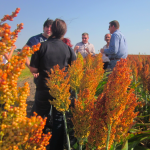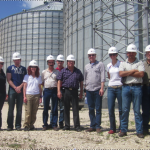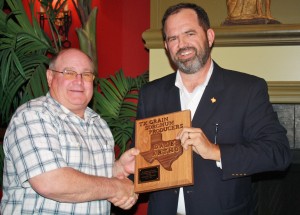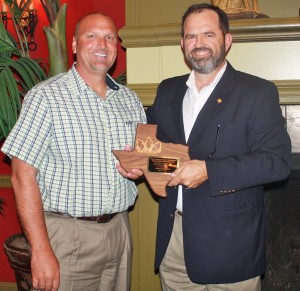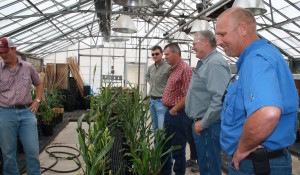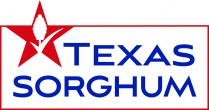- About UsTexas Grain Sorghum Association is….
- Texas Sorghum InsiderNewsletters…
- Legislative News
- Photos
- Contact UsTexas Grain Sorghum Association P.O. Box 905 Salado, TX 76571 Wayne Cleveland, Executive Director wcleveland@mindspring.com (254) 541.5375 Morgan Newsom, Producer Relations Coordinator morgan@texassorghum.org (806) 438.5994 SEND US A MESSAGE: [contact-form-7 404 "Not Found"]
- Sorghum Dashboard
- Events
August 29, 2012
Check Out Our Websites! – TGSP offers two new websites for you to find information. Texas Grain Sorghum Association (TGSA) which concentrates on state legislative issues can be found at www.texasgsa.com and Texas Grain Sorghum Board (TGSB) which enhances the sorghum through research, marketing and education can be found at www.texassorghum.org. The websites offers various information including: a list of our districts and the board of directors, commodity futures, USGC’s market perspective reports, Texas AgriLife Extension’s sorghum tips, archives of our newsletters, photos, upcoming events and more, and will soon have information on grain storage, sorghum 101, and reports on the marketing and research projects TGSB funds each year. If you would like to see something on our site, please let us know!
How Much Do You Spend on Food and How Secure is Your Food Supply? – A project sponsored by DuPont and collaborated by The Economist Magazine answers those questions and a whole lot more. The link http://foodsecurityindex.eiu.
DuPont Pioneer Sorghum Breeding – Cleve Franks, a sorghum breeder at the Pioneer facility in Plainview, Tex, updated Texas Grain Sorghum Board of Director’s on Pioneer’s sorghum breeding program at our August board meeting. Pioneer’s sorghum breeding program has three locations and are located in Plainview, Tex., Taft, Tex. and Manhattan, Kan. Their programs have 20,000-30,000 plots in their home nurseries and 8,000-10,000 plots in their winter nurseries. Their sorghum breeders’ implement trials at their home locations and also at 10-12 off-site locations, and in their spare time (ha) implement 20,000-30,000 yield trial plots each year. The goal of the breeding program is to stack favorable genes in new ways, where yield is always a consideration. It takes a typical program 9-10 years to get from a single male and female breeding line to sell commercially to producers. The trials of the hybrids usually account for six of those years. To go commercial, a hybrid must be superior to those that are currently released. Pioneer invests large amounts of dollars to sorghum research and are able to implement such technologies at the BOREAS mobile wind machine. Pioneer is also preparing for over-the-top grass control technologies and hopes to have their resistant sorghum varieties to the ALS herbicide released in 2015.
Sorghum Head Worm – Dr. Ed Bynum of Texas A&M AgriLife Extension Service in Amarillo recently released an update on sorghum head worms in the Panhandle region. He noted that the larvae of both fall army worm and corn earworms/cotton bollworms make up the caterpillars known as sorghum head worms. The sorghum head is most susceptible to damage during flowering to soft dough growth stages and infestation is usually worse in late-planted fields versus early planted ones. He also noted that loose, open type heads usually have a lower number of head worms than tight sorghum heads. Dr. Bynum suggests sampling your fields each week during the grain developing stages. Texas AgriLife has released a threshold calculator at http://bailey.agrilife.org to determine the economic effects and whether or not growers should consider using chemicals on these pests. For sampling techniques, please contact your county extension agent.
High Plains Farm-Forward Study – Dr. Darren Hudson, a professor and researcher in Agricultural Economics at Texas Tech University, visited with Texas Grain Sorghum Producer’s Board of Director’s last week and provided the results from the Farm-Forward economic study he did that shows the impacts of changes at the farm level on agribusiness supply chains and communities in the High Plains region since irrigated crops pump 90% of the water. Texas AgriLife Extension Service were also key researchers in the study. The study estimates the forward-linked (output of each forward-linked sector associated with the purchase of locally produced commodities) regional impacts for agricultural products and found that the total impacts of crop production outputs were $12,235 million, with a value added total of $4,662 million and agriculture employs 103,297 jobs in that region. The study also broke out each field crop in the region and also showed livestock effects. Sorghum production accounted for a total impact of $725 million outputs, had a value-added impact of $291 million and employed 5,988 jobs. Sorghum silage contributed to a total of $100 million outputs, had a value-added impact of $37 million and contributed for 621 jobs. The study is available to help with alternative water policy analyses within the region.
August 15, 2012
Jeff Stapper Awarded Sorghum Extension Agent of the Year – Jeff Stapper, County Extension Agent in Nueces County, was presented with Texas AgriLife’s Sorghum Extension Agent of the Year award at the Extension Agent’s annual meeting held at the end of July. Mr. Stapper’s regional director, Monty Dozier, noted that Jeff uses a variety of methods to reach producers related to grain sorghum production. He has extensive on-farm trials that he implements each year. In 2011, Jeff’s trials included studies related to grain sorghum varieties, sorghum fertility management, sorghum planting methods, and sorghum herbicide tolerance. Jeff is always providing information to his producers through face-to-face interaction, at meetings, in print and electronic media and on television. Last year he held a grain production workshop and implemented various other workshops on crops grown throughout the county. Mr. Stapper played an important role during the Sorghum Checkoff referendum in relaying information to producers. As a token of our appreciation, Texas Grain Sorghum Producers will be sending Jeff to the annual Commodity Classic in the spring of 2013 where he can network with industry leaders and growers across the nation and learn about the newest innovations in with grains. TGSP congratulates Mr. Stapper on this outstanding achievement and we look forward to continue to work with him in the future!
Monte Alto Variety Tests Results – Texas AgriLife recently released their results from their fully irrigated and limited irrigated grain sorghum performance tests in Monte Alto at their variety plots at Rio Farms Inc. The fully irrigated test plot averaged 8,096 lbs/acre. There were 38 hybrids in the trial, and 19 of the hybrids produced over 8,000 lbs/acre. The highest yielding hybrid was Pioneer 84P80 at 9,537 lbs/acre with a test weight of 59.6, and the second highest yielding hybrid was Monsanto Company’s DeKalb DKS51-01 at 9,467 lbs/acre. The limited irrigated test plot averaged 8,021 pounds/acre with an average test weight of 58.1. There were 42 varieties in this plot, and 19 produced over 8,000 lbs/acre. The highest yielding hybrid in the limited irrigated plot was also Pioneer’s 84P80 at 9,275 and second was also Monsanto Company’s DeKalb DKS51-01 at 9,190. To see all the results from this performance test, please visit http://varietytesting.tamu.
DuPont Pioneer to Celebrate 50 Years in Plainview – The DuPont Pioneer company will celebrate its 50th anniversary of its Plainview production facility on August 30. Sorghum is the primary crop that is produced at this facility and as marked on Pioneer’s website it was a milestone for the company – in 1962 “Pioneer sorghum operation begins in Plainview, Texas.” This year the facility is growing its largest sorghum seed crop it has ever seen. After harvest wraps up, they will then prepare the sorghum seed and ship it all over the world.
3rd Annual South Texas Commodity Symposium – Texas Grain Sorghum Producers, Corn Producers Association of Texas, South Texas Cotton and Grain and Southwest Council of Agribusiness will once again team up to bring a commodity symposium to South Texas growers. For the first time, the event will be held in conjunction with the Robstown AgXchange Farm & Ranch Show at the RMB Regional Fairgrounds in Robstown, Tex. Mark your calendars for Thursday, October 4th and plan to join us at 10 a.m. to discuss the Farm Bill, the Texas Grain Indemnity Fund and hear from Texas Agriculture Commissioner Todd Staples on border control and immigration issues. The event will conclude with tickets to eat lunch at the AgXchange BBQ cookoff. More information will be coming soon on the symposium, but in the meantime visit www.texasagxchange.com to view what the new Texas AgXchange will be bringing to Robstown to growers in South Texas!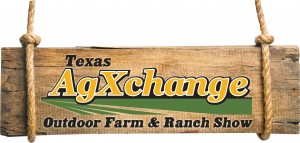
July 24, 2012
Texas A&M Agencies Plan Formal Name Changes – Seven state agencies of the Texas A&M system will be officially renamed at the Board of Regents meeting set for Aug. 2, 2012. Texas A&M has the goal of maintaing a stronger agency brand for the future to maximize the benefits of the shared equity in the Texas A&M name. A new logo will be created for the agencies, but there will be no changes in lines of authority or reporting relationships. Three of the seven examples of the name changes include: Texas AgriLife Extension Service will be Texas A&M AgriLife Extension Service; Texas Transportation Institute will be Texas A&M Transportation Institute; and Texas Forest Service will be Texas A&M Forest Service.
USDA to Assist Farmers & Ranchers Suffering in Drought – Agriculture Secretary Vilsack announced recently USDA’s new flexibility and assistance plan in their major conservation programs to offer much needed help to producers as the most wide-spread drought in seven decades intensifies in the U.S. So far, USDA has designated 1,297 counties across 29 states as disaster areas. He noted that many farm families will be struggling to make ends meat at the end of the crop year. The four programs within USDA that Secretary Vilsack’s is using his discretionary authority over are as follows: the Conservation Reserve Program (CRP) – by allowing additional acres under CRP for haying and grazing under emergency conditions; the Environmental Quality Incentives Program (EQIP) – by allowing producers to modify current EQIP contracts to allow for prescribed grazing, livestock watering facilities, water conservation and other conservation activities to address drought conditions; the Wetlands Reserve Program (WRP) – by authorizing haying and grazing of WRP easement areas in drought-affected areas where such haying and grazing is consistent with conservation of wildlife habitat and wetlands; and the Federal Crop Insurance Program – by encouraging crop insurance companies to help producers who may have cash flow problems to voluntarily forego charging interest on unpaid crop insurance premiums for an extra 30 days, to November 1, 2012, for spring crops. Policy holders who are unable to pay their premiums in a timely manner accrue an interest penalty of 1.25 percent per month until payment is made. For more information, visit www.usda.gov/drought.
Texas Sorghum Prices Staying Strong – As the drought lingers across the Midwest and dampers the corn crop, the futures prices continue to climb. At the end of last week across the state for delivery to elevators, the Rio Grande Valley was said to be averaging a cash price of $6.51/bu for sorghum, the Texas Upper Coast compared at an average of $6.46 while the Coastal Bend averaged $6.78. Central Texas compared to the southern region offering an average of $6.72 for sorghum. Currently, the Northern and Southern High Plains are almost a dollar higher than the other parts of the state, but they are the only ones not finished with or in harvest. Their prices averaged in range from $7.67 to $7.76. Export prices ended last week relative to the region – with the New Orleans port offering the highest price at $8.19.
July 10, 2012
Sorghum Checkoff Looking for Leadership – The United Sorghum Checkoff Program (USCP) is launching a new program to look for the next generation of leaders in the sorghum industry. The program is looking for interested applicants who are actively engaged in growing sorghum. Those who get accepted into the program will have both hands-on and a classroom style education. The class will be exposed to various aspects of the sorghum industry from basic research to international marketing, and participants will gain an understanding of how sorghum moves through the value chain, how checkoffs and interest organizations interact on behalf of the industry and what the future holds for the crop. The program will also provide professional development training and networking opportunities. Applications for the Class I of Leadership Sorghum are due by July 20, 2012. For electronic forms and class schedules, please visit www.SorghumCheckoff.com/leadership or email leadership@sorghumcheckoff.com. We hope that you will get involved!
West Texas Ethanol Plant – Earlier this year the former Levelland/Hockley County Ethanol Plant went bankrupt and a local market for sorghum left with it, but Conestoga Energy has recently bought the plant and this is good news for area farmers. The new plant is called Diamond Ethanol, LLC and they plan to be up and running in time for sorghum harvest in west Texas this fall. The company hopes to be doing some testing of the plant by mid-September and plans to be taking sorghum by October 1, 2012. The ethanol plant plays a large role in boosting the local economy and gives area growers a local market for their sorghum crop. The plant will be working very closely with the local cooperatives to purchase the sorghum for their operation.
Crop Report – Texas AgriLife recently reported on crops across the state. The Southern High Plains has seen more sorghum go in the ground as the heat index soared and some cotton got hailed out. Many cotton fields that got hailed out were replanted with sorghum. The irrigated fields look fair but need rainfall to supplement the irrigation. Sorghum in the Panhandle is fair to good. Rains have began to flicker around both regions but is always needed as irrigation is still in full swing and the dry land crops are aching for it. Sorghum in Central Texas is still holding on and looking good. Temperatures have been high and rain has recently been limited. The Coastal Bend ranged from three inches of rain to a trace last week. Sorghum is being harvested in most of the CB, but some areas of sorghum are still getting zeroed out due to the lack of soil moisture. Some of the failed sorghum crops are being harvested for hay while other parts of the region are showing descent yields. The Northern region of Texas showed that grain sorghum yields are expected to be excellent. The Valley is nearing the end of sorghum harvest as rains from last week slowed progress just a bit.
June 28, 2012
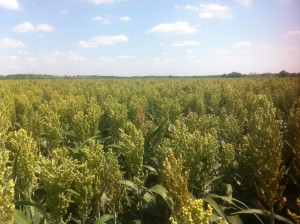
Ken Davis' sorghum crop in Grandview shows potential for high-yielding sorghum in Central Texas this year.
Sorghum Seed Industry Gets Newly Converted Lines – The United Sorghum Checkoff Program (USCP) is currently funding the re-instated Sorghum Conversion Project in conjunction with MMR Genetics (NuSeeds America) and USDA-ARS to make more of the world’s sorghum available to breeders through newly converted germplasm. The researchers selected 44 sources of germplasm grown around the world that could not be grown in North America and converted these plants into desirable traits that can be grown in the U.S. The 44 germplasms were released this May to seed companies around the nation so that they could begin their trek to provide these possibilities to producers by bringing new traits, new uses and new markets. The new material is currently available to public and private use institutions for the development of new hybrid lines. The next release, which is scheduled for May 2013, will feature 50 newly converted lines.
NSP Revamping Yield & Management Contest – National Sorghum Producers (NSP) have agreed to add two new divisions to their National sorghum yield and management contest. The two new categories that will be added to the competition will be double crop irrigated and double crop non-irrigated. This will allow producers who plant sorghum behind a previously harvested crop in the same crop year to compete on a more level playing field among their peers. Other categories include: conventional-till irrigated and non-irrigated, no-till non-irrigated, mulch-till non-irrigated and reduced-till irrigated.Entry forms must be postmarked at least 30 days before harvest for “Regular Entry” of $65 or at least 10 days before harvest for “Express Entry” of $95. You must be a member of NSP to participate. Dues are $60 for a 1-year membership or $150 for a 3-year membership. For an entry form to the contest, please contact Morgan Newsom at morgan@texassorghum.org.
Onyx Black Sorghum – Dr. Bill Rooney of Texas A&M University has developed Onyx, a type of black sorghum that is a game changer in the sorghum food market. The new finding shows that the outer layer of the grain sorghum, also known as bran, is a black color which has a high concentration of anthocyanins which are antioxidants. Dr. Rooney noted to Sealy news that this line “would be suitable for the food market, you could grind this and turn it into flour for food use.” The yield potential of this line is approximately 65-70 percent of a commercial grain hybrid. Dr. Rooney also noted the line was developed for a niche market-production and will not be widely grown or distributed. The line is currently in the licensing phase, so we expect to see it in the near future.
Japanese Trade Team Visits Texas – Last week, the U.S. Grains Council, the United Sorghum Checkoff Program and Texas Grain Sorghum Producers hosted a team of five potential sorghum buyers from Japan while they toured Texas to learn about sorghum’s potential as a feed grain and the role it plays in human consumption. The group first toured Attebury Grain’s facility in Saginaw and then made a stop at Ken Davis’ operation to view sorghum fields near Grandview. The group then went on to Texas A&M University where they heard presentations on research being done with sorghum for food as well as toured the Universities research plots. Japan is the nation’s second largest importer of sorghum and our organizations continue to build on that relationship to sell them more grain.
June 12, 2012
Crop Insurance Debate Still Making Ripples – As Farm Bill discussions continue, crop insurance still remains a hot topic. Producer groups urge congress to leave the crop insurance section of the Farm Bill the same as the one in 2008, as it is a safety net and a leverage to be able to continue to produce the safest and most abundant food and fiber supply in the world, but other groups are seeking amendments that would limit and drastically reduce the chance for crop insurance to do what it was meant to do. AgWeek reported that The American Association of Crop Insurers and the Crop Insurance and Reinsurance Bureau are urging the Senate to reject all the amendments that would change the crop insurance section of the Farm Bill, but reform coalitions are urging the senators to consider passing them. The four amendments are trying to limit crop insurance to “wealthier” farmers, limit crop insurance premium subsidies, and amendments that would mandate conservation requirements in order to get crop insurance.
Texas Sorghum Growers Still Needed for Study! – The United Sorghum Checkoff Program (USCP) is funding an in-depth study that involves tracking all data used by sorghum growers to raise, harvest and market their sorghum crop. The study will begin in June 2012 and participating growers will be asked to provide information relating to all inputs and outputs relating to their crop. The data will be used to assess the carbon footprint of growing sorghum versus other crops, and a model will be developed to demonstrate those interactions. The study still needs several Texas sorghum growers so if you are interested in participating or know someone who is, please contact Dusti Fritz of USCP at dusti@sorghumcheckoff.com. The series will include four 5-to-10 minute surveys online and will be conducted by SGS and Strategic Marketing Research and is strictly a scientific resesach project that does not include sales of any kind.
Grain Basis Trading Online Course Available – Students and professionals can embark on a 14-week online course to gain a detailed working knowledge of how basis trading concepts and practices are applied to agricultural markets and to help develop a skill set that can be put immediately into practice in any basis trading operation. Grain basis trading is the process by which grain firms use the futures market to offset price risk and to profit from merchandising grain. The course is put on by a collaboration of White Commercial Corporation and the University of Arkansas. The course is designed for people who have background knowledge of futures markets and basic risk management strategies. Learning times are flexible but guided by a specific schedule. Once the course is satisfactorally complete, a achievement certificate of Basis Trading Administration-Level 1 will be provided. To gain more information and register visit the Grain Basis Trading Website at http://globalcampus.uark.edu/gbt.
Potential Sorghum Buyers from Mexico Visit Texas– Texas Grain Sorghum Producers Board (TGSB), the United Sorghum Checkoff Program (USCP) and the U.S. Grains Council (USGC) hosted and sponsored a group of potential sorghum buyers from Mexico into Texas last week. The group toured around the Coastal Bend to learn about the Texas sorghum crop. Jim Massey IV, TGSB board member, showed the group sorghum crops in the area, explained the process of growing and harvesting sorghum, and showed the group farm equipment. The groups also toured Gulf Coast Coop and Woodsboro Coop while in the area. Finally, the group finished off with a barn dinner at Bobby Reider’s near Sinton, Tex., where the group visited with more than 40 attendees including area producers, elevator managers and industry leaders. The buyers from Mexico included a dairy operator, a feed mill operator, a Tyson representative, a buyer consultant and a grain merchandiser. TGSB, USCP and USGC will host of potential Japanese sorghum buyers into Texas June 17-19.
May 30, 2012
Grain Sorghum Inches Closer to Becoming an Advanced Biofuel – The U.S. Environmental Protection Agency (EPA) recently issued a notice of data availability (NODA) concerning renewable fuels produced from grain sorghum under the Renewable Fuels Standard (RFS) program. The National Sorghum Producers (NSP) has worked for over two years with EPA to get grain sorghum listed as an advanced biofuel which helps mandate plants to produce grain sorghum-based ethanol. EPA’s analysis shows grain sorghum has a greenhouse gas emissions reduction (GHG) of 32 percent when used to make ethanol at facilities that use natural gas. Also according to EPA, when grain sorghum is used to make ethanol at facilities that use biogas digesters in combination with heat and power technology, it achieves a lifecycle greenhouse gas emissions reduction of 53 percent which qualifies it as an advanced biofuel under the RFS. The NODA will have a 30-day comment period and NSP will be submitting comments to the EPA. For more information please contact NSP at (806) 749-3478.
USDA Moves Forward with Office Consolidation – The U.S. Department of Agriculture (USDA) announced its decision to move forward to consolidate Farm Service Agency (FSA) county offices. FSA will consolidate 125 of the 131 offices originally proposed for consolidation with other USDA service centers that are consistent with the 2008 Farm Bill. The process is listed under USDA’s Blueprint for Stronger Service which modernizes and accelerates service delivery while improving the customer experience through innovative technologies and business solutions. The Blueprint also includes a plan to close or consolidate 259 domestic offices including the FSA offices, additional facilities and labs, and seven foreign offices. The two criteria that USDA followed in deciding which offices will be closed were 1) identified FSA offices located less than 20 miles from another FSA office that had two or fewer permanent, full-time employees and 2) all FSA offices with zero permanent employees regardless of location. Public meetings and comments were then held in the affected counties and USDA found that 6 of the original 131 proposed offices did not meet the criteria for consolidation, and are not included in the final plan. FSA will provide farmers and ranchers with consolidated offices the opportunity to choose the most convenient neighboring county office to conduct future business and all employees in closing offices will be provided an opportunity to continue their work with FSA. The Texas FSA offices that are required to consolidate include the following counties: Andrews, Cass, Delta, Hutchison, Lee, Midland, Mills, Roberts, Rusk, San Augustine, Shelby, Upshur, Val Verde, Van Zandt and Waller.
Syngenta Settles Atrazine Litigation – Syngenta and attorneys for several community water systems have agreed to settle litigation related to the herbicide atrazine in order to avoid the business uncertainty and expense of protracted litigation. Syngenta acknowledges no liability and continues to stand by the safety of atrazine. The scientific evidence still makes clear that no one ever has or ever could be exposed to enough atrazine in the water to affect their health. The plaintiffs acknowledged they do not know of any new scientific studies relating to the safety of atrazine. The proposed settlement requires court approval and water systems joining the class will be eligible for payments from a $105 million settlement funded by Syngenta. Syngenta notes that the settlement is good for the company and the farmers who depend on atrazine, as well as their retailers, distributors, partners, and others who have been inconvenienced by this litigation. The litigation began almost eight years ago when a group of comity water systems claimed that Syngenta should pay to filter atrazine from their water supplies. Atrazine benefits American farmers by up to $3.3 billion and supports up to 85,000 American jobs related to farming while helping protect the environment and critical wildlife habitat by reducing soil erosion by up to 85 million tons each year. There is no substitute for atrazine which is a critical weed control product used in grain sorghum and other crops and is used in more than 60 countries.
May 15, 2012
Staples Awards Disaster Grants – Agriculture Commissioner Todd Staples announced awards of $2.1 million in federal disaster relief grants to Texas cities and counties who are still suffering the effects of the severe drought from last year. The communities being awarded are: Concho County, Falls City, Lawn, Leakey, Real County and Sabine County. The funds were made available from a new initiative that directs funds toward drought needs from the Texas Department of Agriculture’s (TDA) Texas Community Development Block Grant Program. TDA awarded the grants from its Disaster Relief Fund, which provides assistance to eligible communities to help alleviate the effects of a natural disaster. The program serves approximately 1,017 eligible rural communities, 245 eligible rural counties and provides services to more than 375,000 low-to-moderate beneficiaries each year. Counties must have populations less than 200,00 people, and cities must have populations under 50,000.
2012 National Sorghum Crop Projections – The USDA has set projections for the new sorghum crop year. The 2012 U.S. sorghum crop is expected to produce up to 335 million bushels this crop year (up from 214 million last year). Reports indicate planted acreage is expected to increase to a total of 5.95 million acres (up 469,000 acres), while the yield is projected to jump 10.4 bushels. Sorghum beginning stocks are forecasted at 26.9 million bushels (down 0.6 million) and total production is set to be at 362 million bushels (up from 242 million) due to the higher production levels. Sorghum use is expected to increase by 105 million bushels. Exports are projected higher at 140 million bushels (up 80 million), while feed and residual use is projected at 90 million (up 25 million). Ending stocks are expected to be at 42 millions bushels (up 15 million). The season-average farm price is projected to be $3.85-$4.65 per bushel (down from $5.85-$6.15).
Reminder! DCP & ACRE Deadlines Approaching – The U.S. Department of Agriculture (USDA) Farm Service Agency (FSA) reminded producers that enrollment for eligible farms the 2012 Director and Counter-Cyclical Program (DCP) and the Average Crop Revenue Election Program (ACRE) ends on June 1, 2012. Producers must enroll their farms each year and all owners and operators who will share in the DCP or ACRE program must sign-up. Since 2009, producers had the option to choose one program or the other, and a producer who initially chose to remain in DCP has the option to switch to ACRE during the enrollment period, but producers who chose to enroll in ACRE in the past cannot switch back to DCP. Growers can enroll on the electronic DCP (eDCP) at www.fsa.usda.gov/dcp which saves time, reduces paperwork and speeds up contracts processing (must have an active USDA eAuthentication Level 2 account which can be completed online at www.eauth.egov.usda.gov) or by visiting their local FSA office.
May 1, 2012

Sorghum crops in the Texas Coastal Bend look promising as the crop year moves forward – April 26, 2012.
Sorghum Growers Needed for Study – The United Sorghum Checkoff Program (USCP) is funding an in-depth study that involves tracking all data used by sorghum growers to raise, harvest and market their sorghum crop. The study will begin in June 2012 and participating growers will be asked to provide information relating to all inputs and outputs relating to their crop. The data will be used to assess the carbon footprint of growing sorghum versus other crops, and a model will be developed to demonstrate those interactions. If you are a sorghum grower and are interested in participating please contact Dusti Fritz of USCP at dusti@sorghumcheckoff.com. The series will include four 5-to-10 minute surveys online and will be conducted by SGS and Strategic Marketing Research and is strictly a scientific resesach project that does not include sales of any kind.
Senate Ag Committee Passes Farm Bill – After much speculation, the Senate Committee on Agriculture, Nutrition and Forestry passed the Agriculture Reform, Food and Jobs Act of 2012 by a vote of 16-5 on April 26th. More commonly known as the “Farm Bill”, this piece of legislation will move to the Senate floor this summer. The House Ag Committee will begin mark ups in the next few months. National Sorghum Producers (NSP) and other agricultural groups worked tirelessly to make farmers voices heard. The Senate Ag Committee’s legislation was a major shift in policy with potentially major implications for the sorghum industry. NSP stated it believes it is vital to build a program that allows equitability among commodities to encourage crop diversity and rotation on the farm. NSP has some concerns regarding the Commodity Title, but noted there are some positive changes in the Insurance and Conservation Titles. NSP will continue to represent growers as this legislation moves forward.
FSA Offers New On-line Tool – USDA Texas Farm Service Agency (FSA) announced that farmers and ranchers in Texas now have a more efficient, timely option for receiving important FSA program eligibility requirements, deadlines and related information. FSA is offering a free online communications through their GovDelivery electronic news service and news will be sent directly to your home or farm office, or to your Smartphone. Growers can sign-up to receive information based on topic and/or location. You can subscribe online at http://www.fsa.usda.gov/subscribe or contact your local FSA office for assistance.
TDA’s Family Land Heritage Program – The Texas Department of Agriculture (TDA) is accepting applications for their Family Land Heritage (FLH) Program. FLH recognizes farms and ranches for continuous agricultural production by the same family for 100 years or more. The families being awarded will be honored at a ceremony in Austin and will receive a certificate, will be eligible to purchase a Texas historic farm or ranch gate sign and/or bronze marker to display on their property. To qualify to apply for the FLH the same family must have maintained the land in continuous agricultural production for 100 years by blood, marriage or adoption. Families must be able to trace the line of ownership from the first family member to the present one. The land must be 10 acres or more with agriculture sales of $50 or more a year; or if less than 10 acres, sales of at least $250 a year, and owners must be actively managing the everyday operation. More information on the rules and the application may be found at www.tda.state.tx.us. Applications must be postmarked by June 1st.
Sorghum Foundation Seeking Scholarship Applicants – The National Sorghum Foundation was established to promote and aid higher education in agriculture and to promote the study of sorghum and its impacts on agriculture. Producers, researchers and private industry collectively fund the Foundation endowment. The Foundation offers two scholarships – the Darrell Rosenow Memorial Scholarship in the amount of $1,000 to be applied to one semester of education expenses and the Sorghum Challenge award winner in the amount of $1,000 to be applied to one semester of tuition expenses and also a trip to Washington, D.C. with NSP during their annual fly-in. For more information, please contact Dr. Bruce Maunder at texasgreenbug@aol.com.
Three TGSB Board of Directors Retire –
Last week, the Texas Grain Sorghum Producers Board (TGSB) bid farewell to three of its directors as they moved on to retirement. Jim Boston of Roscoe served on the board since 1988, Dale Artho of Wildorado served since 1994, and Robert Hoot of Raymondville served since 2000. TGSB thanks those directors for their time, dedication, service and leadership to the Texas sorghum industry. With their retirement, three new elected board members were sworn into their seats – Blake Tregellas of Perryton, Kathy Brorman of Hereford and Glenn Wilde of Lyford begin their duties and we are excited for their leadership. Also, Troy Skarke of Claude ended his four-year term as Chairman and Chuck McDonald of Monte Alto was elected into this new position.

